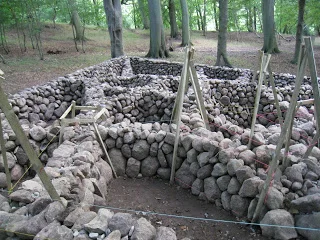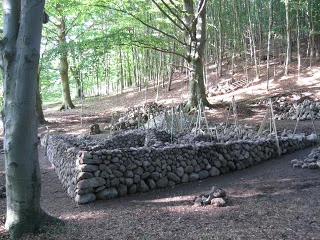Here’s a little secret about building a dry stone wall on a busy construction site: work on the holiday. I spent the Memorial Day weekend constructing a seating wall for the Hall Art Foundation in Reading, Vermont. While packs of touring motorcyclists occasionally rumbled past on Route 106, bird song was the predominant sound track. No distractions from the other contractors, who are busy there on the weekdays, meant I could concentrate on the task at hand. I built two sections of wall beside one of the galleries at Vermont’s newest art museum.
Read MoreTrick-or-treaters had the trick played on them this autumn when a pre-Halloween Nor’easter dropped a foot of snow on our area. Witches and goblins don’t usually have to scale snowbanks to ring doorbells. And I don’t expect my stone supplies to disappear under a blanket of white stuff in October. But after a short delay, the project I had scheduled for last week got underway and a 100’ length of “singling” was produced for Cochecho Country Club. This style of dry stone walling is well suited to a materials supply constituted of boulders. The stone was resurrected from the remnants of an old field wall. The wall line was reestablished and a crushed-stone base installed.
Read MoreDry stone walling can be defined in its simplest terms as the act of placing one stone on two. But no sooner is that act completed when a much broader world view opens to the stone worker. This understanding was the basis of the one-day workshop held last Saturday in Dummerston, Vermont. Eleven participants from around New England came together to hear talks on forestland and geology, and build dry stone features alongside town hiking trails. Visiting walling instructor and DSWA Mastercraftsman Dave Goulder, from Rosehall, Scotland, joined me in taking the group on an exploration of the local cultural landscape.
Read MoreWhen I built this wall in Jamaica, Vermont, thirty-odd years ago, my concern for its longevity came out of its close proximity to the road. I expected a car might back into it, or the snow plow jostle it. The notion that Ball Mountain Brook might one day destroy it never crossed my mind. But that’s just what happened a month ago when rain from Hurricane Irene turned the mild stream into a raging cataract. Brook waters tore away the bank, sweeping away not only a section of the stone wall but half the house, as well.
Read MoreCongratulations go out to Brian Post on his successful completion of Part A of the DSWA Level 3 certification test. Brian chose the ‘lunky hole’ feature to build alongside the mandatory curved wall section. He built his test pieces at the Stone Trust indoor training and testing facility in Dummerston, Vermont.
Read MoreStone I harvested back in July got a work-out this week in the construction of a small foundation for a neighbor. Even before the new woodshed was completed, its builder was contemplating the addition of a space to store yard carts. Consequently, I was asked to build a dry stone foundation off the south end of the structure. Two wood posts, anchored to the granite sill-stones, will support a beam and rafters attached to the side of the building. The mass of the stone work visually establishes the woodshed in the landscape, and its top surface functions as a rugged floor for the cart shed.
Read More“Diamond Mines” is an abstract, site-specific sculpture built of loose, natural stone. The work is situated on westward-sloping ground in a grove of mature beech trees. Wooded hills rise to the north and south. Park paths wind along the west and north sides of the sculpture. To the west, Tranekær lake and castle can be viewed. ‘Diamond’ is the perimeter, outline shape of the sculpture. The shapes of the nineteen interior facets are also diamond. There are a total of eighty-five obtuse and acute angles in the sculpture. The stones are set on their near-vertical axis in the construction, pointing up and down in the wall faces. In “Diamond Mines” there are diamonds within diamonds within a diamond.
Read MoreThe building of “Diamond Mines” was a delightful experience due to the many wonderful people who helped make it possible. Thanks go to my new Danish friends; Alfio, Lone, Ole, Birthe and Trine. To on-site workers Francesca and Jared goes my grateful appreciation. Always behind the scenes and in the middle of it all was Elin, who supported me in every moment and was my guiding light at every turn.
Read MoreThis song, from Mark Knopfler and Emmylou Harris’s “All the Roadrunning” album, makes a good anthem for those of us who grub our living out of the ground. We stone workers labor to lift something special from the earth. Our efforts are mainly brutish and blunt but we continue day by day in the belief that something beautiful will arise in the end. When it finally does, the light of what we’ve created shines briefly before for us. And then we must turn our backs and leave it all behind.
Read MoreAbout once an hour, or so, someone walks by the site and asks me what I’m doing. Often they wonder if I am repairing something. I’ve been told the piece looks like a temple, fishponds, and human tissue under a microscope. “How long before it’s finished?” and, “What’s it called?” are the common follow-up questions after they hear I’m building a new abstract sculpture for TICKON art-park. I can now say that it will be finished in a few days, and that the piece is called “The Diamond Mines.” It’s been a rare experience for me; spending these past weeks in a grove of stately old beach trees. Plus, daily visits from Elin, and picnics with her Danish family, have quickly turned this project into an all-time personal favorite.
Read MoreWorking hands inform thought and awaken understanding of the art builder's place in the natural world. Undulant lines and patterned spaces are the result of many choices made by the art builder who recognizes, and utilizes, the unique character of stone. The presentation will examine the many uses of stone in art; how stone can support a design, or simply be the art itself. It will also explore the "give and take" experience of working in nature, and the connection to spirit expressed through stone.
Read MoreSculptor Markku “The General” Hakuri marshaled a merry band of art lovers in the destruction of the pieces he exhibited in the Kerava Art Museum this summer. The closing ceremony of the show included a parade of dismantled sculpture parts and their burning in a bonfire. After the fire died down we proceeded to tumble my sculpture “Wishing Wells”. From its conception, my piece was destined to be removed at the end of the show, so, we had a fun time pulling out stones and watching the well walls cascade to the ground. Most delightful was the musical sound made by the downpour of cobbles.
Read MoreThe TICKON installation is past the halfway mark thanks to the help of Alfio Bonnano and Ole Johnsen who have coordinated all the logistics of tools and materials, plus, made us feel at home away from home. On site, Francesca and Jared have put in long hours raising the walls of the piece that will soon be the newest addition to the art park. Elin has been busy orchestrating the myriad details of working and living away from Vermont, and documenting the process and progress of the installation.
Read MoreIt took me a few days to ‘get’ TICKON’s method of operation but I can now appreciate it for its full value. The art park owns no tools or equipment. Everything needed to produce a new installation is gathered piecemeal from community members in the surrounding villages. So, for the first few days of my project I rode around the countryside with Ole each morning popping in on local folk to have a chat. We explained what the project was, and what we were looking for. Eventually the tools and materials came together. In the process, more and more people became involved in the project. They have helped to create a new art work at TICKON. “Mange tak” to all those who have made me feel welcome in the Kommune of Langeland.
Read MoreWhile the supply was drying out I began setting up batter frames. Each board describes an inside corner of the construction. Because the wall intersections are many different obtuse and acute angles, each board is set to correspond to the intersection angle and to the wall batter. The wall batter is 2.5” in every 12” of vertical height. Work on the piece begins at the center and moves out toward the perimeter as progress is made over the next few weeks.
Read MoreThe previous post elicited a question from a reader about the dry stone cairn in the top photo. It’s a trail marker, one of hundreds found alongside the old routes in Norway for crossing the high country from one valley community to another. They are spaced approximately 50 meters apart to help guide those traveling in fog, snow or low light conditions. The pine poles atop them may be all that’s visible in a sea of winter white.
Read MoreFrom the glacier fed streams of Norway’s Jotunheimen mountains, I’ve traveled this past week to the low, wetlands of Denmark. In fact, I’m living in a 300 year-old house alongside a castle moat. This is the artist’s residence for TICKON, the environmental art park I’ll be working in for the next month. Yesterday 20 tons of stone was gathered from field piles and delivered by the tractor-wagon load to the site of my construction. Today the outline of the work will be established and guide frames erected.
Read More
















